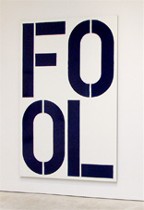
Two of the best shows I saw in New York Tuesday had pop lyrics from the weed-choked Vietnam War era. “I am the Walrus” is the name of a terrific show with a clown theme from a wide range of heavy hitters in the art world, and “I Want to Take You Higher” is a surprisingly varied group show of mandalas that use and abuse the form’s traditional spiritual enterprise.
The shows seem a perfect fit for our times, what with an unpopular war raging, an unpopular government governing, and the smell of marijuana wafting down city streets.
A thousand clowns
What struck me about “Walrus,” at Cheim & Read, however, is not the nostalgia for some old kind of humor but rather the currency of most of these artists, whose in-your-face approach to humor is so popular today. Like Letterman and Larry David, the clowns here are not always first and foremost self-deprecating. More often than not, they are quite the opposite.
Bruce Nauman’s clowns jump up and down screaming “No” in an excruciating pitch in his video piece “No No New Museum.” Christopher Wool’s painting “Fool” (top) addresses the viewer’s foolishness as well as his own.
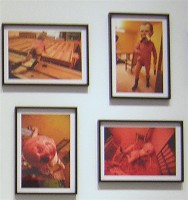
And Paul McCarthy, is in hot form in “Basement Bunker,” a grid of 28 photographs with images of violence so disgusting and bloody–the little elves and dwarfs of the free world, including our fearless leader in the White House, gone wild with hatchets and such–that he dares you to look without flinching and to find the humor (detail left).
Some highlights of this show include twin portraits by John Waters of Clarabelle, the “Howdy Doody Show” clown, that look like video stills taken off the tv screen. It’s the only piece in the show with a touch of nostalgia. After all these years, I was moved by seeing the human through the makeup.
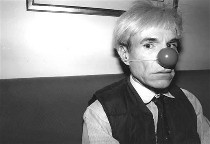 And speaking of humans behind clown noses, a portrait of Andy Warhol, Christopher Makos’ “Andy With Clown Nose,” also shows the man in a reflective moment, putting the lie to the Andy clown-with-fright-wig image that is seared in our collective memories.
And speaking of humans behind clown noses, a portrait of Andy Warhol, Christopher Makos’ “Andy With Clown Nose,” also shows the man in a reflective moment, putting the lie to the Andy clown-with-fright-wig image that is seared in our collective memories.
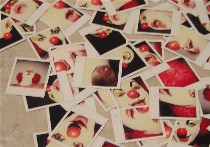 A couple more of my favorites in this show–Ugo Rondinone’s ultra-close-up polaroid shots of a clown (detail left) and a monkey, strewn on the floor where we can step on their faces, and also Olaf Breuning’s photo “Helen Frudin aus America” (right below), showing a bare-breasted Frudin slithering across the floor, her feet inside loaves of bread, her fingers inside rolls (so she looks like one of those tree frogs with the suction-cup fingers) and a Walkyrie-inspired cap adorned with crescent rolls for the horns.
A couple more of my favorites in this show–Ugo Rondinone’s ultra-close-up polaroid shots of a clown (detail left) and a monkey, strewn on the floor where we can step on their faces, and also Olaf Breuning’s photo “Helen Frudin aus America” (right below), showing a bare-breasted Frudin slithering across the floor, her feet inside loaves of bread, her fingers inside rolls (so she looks like one of those tree frogs with the suction-cup fingers) and a Walkyrie-inspired cap adorned with crescent rolls for the horns.

The ridiculous meets the sublime of her noble effort to do whatever she may be doing. And ridiculous though the bread appendages are, her nakedness is arresting.
A thousand colonels
The other ’60s throwback is the show of mandalas, “I Want to Take You Higher,” at McKenzie Fine Art. The surprises of what a mandala can look like and how it can have content that relates more to our culture than to mandalas is what’s great about this show.
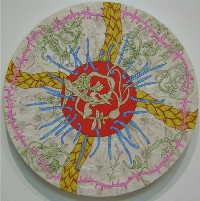 Laura Sharp Wilson’s mandalas (left, “Ani Pachen”) are a riff on antique floral watercolor plates for botany books as well as wallpaper patterns. But these wallpaper patterns will not lie down on the wall and behave themselves. A mix of acrylic and graphite, their intense twining and vining of flower motifs in patterns suggest a freeform mandala format, where the art-historical culture of the East meets that of the West.
Laura Sharp Wilson’s mandalas (left, “Ani Pachen”) are a riff on antique floral watercolor plates for botany books as well as wallpaper patterns. But these wallpaper patterns will not lie down on the wall and behave themselves. A mix of acrylic and graphite, their intense twining and vining of flower motifs in patterns suggest a freeform mandala format, where the art-historical culture of the East meets that of the West.
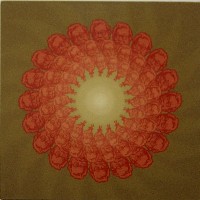 In this meeting-of-the-cultures mode, I enjoyed Aric Obrosey’s “The Symbolic Lotus of a Thousand Colonels,” the KFC symbol twirled into multiples that suggest the overload of advertising we enjoy. Of the layered mylar pieces of Ambreen Butt, all with a woman dead center drawn in a beautiful Persian miniature style, my favorite showed the central figure sucking on a hose or a rope.
In this meeting-of-the-cultures mode, I enjoyed Aric Obrosey’s “The Symbolic Lotus of a Thousand Colonels,” the KFC symbol twirled into multiples that suggest the overload of advertising we enjoy. Of the layered mylar pieces of Ambreen Butt, all with a woman dead center drawn in a beautiful Persian miniature style, my favorite showed the central figure sucking on a hose or a rope.
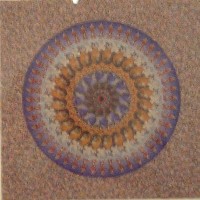
In Marietta Ganapin’s “Untitled (Paris through the Window by Marc Chagall)” (left) and other pieces with a similar approach, Ganapin slices and dices art museum picture postcards of paintings, the imagery repeated over and over again, then whirled by the Western cultural blender.
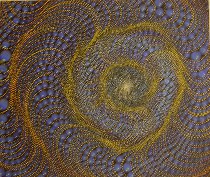 Barbara Takenaga’s “Shaker (Big Blue)” made me think of Fred Tomaselli’s pot paintings and Chris Ofili’s dot paintings, not to mention Bruce Pollock’s meditations. The surprise here is the rectangular canvas which is held together by the looping, Milky Way of tendrils pulling the width of the canvas into an intense center of godhood.
Barbara Takenaga’s “Shaker (Big Blue)” made me think of Fred Tomaselli’s pot paintings and Chris Ofili’s dot paintings, not to mention Bruce Pollock’s meditations. The surprise here is the rectangular canvas which is held together by the looping, Milky Way of tendrils pulling the width of the canvas into an intense center of godhood.
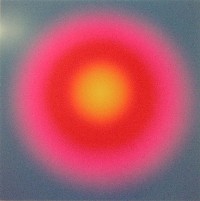 Bill Armstrong’s two mandalas (left, #450) and Miriam Cabessa’s “Blue Circle” use the iris-as-mandala motif. Armstrong adds day-glo colors and ultra-soft edges to make his point–a sort of hopped-up Rothko approach. Cabessa uses a painterly drippy dart shape that looks like it’s penetrating the blue pupil of the big blue eye. Ow.
Bill Armstrong’s two mandalas (left, #450) and Miriam Cabessa’s “Blue Circle” use the iris-as-mandala motif. Armstrong adds day-glo colors and ultra-soft edges to make his point–a sort of hopped-up Rothko approach. Cabessa uses a painterly drippy dart shape that looks like it’s penetrating the blue pupil of the big blue eye. Ow.
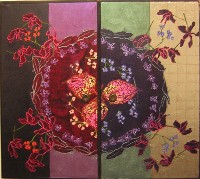 And Robert Kushner decorates a pair of Japanese doors with sexy blooms, glitter, gold leaf and mica to create “First Mandala.” The opulence and decoration are typical Kushner, whose voluptuous fabric creations seem more complex and challenging. But the sense of too-too beauty is still in operation.
And Robert Kushner decorates a pair of Japanese doors with sexy blooms, glitter, gold leaf and mica to create “First Mandala.” The opulence and decoration are typical Kushner, whose voluptuous fabric creations seem more complex and challenging. But the sense of too-too beauty is still in operation.









